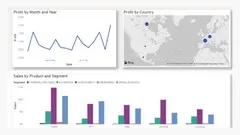
Data Warehouse Concepts Design and Data Integration 
This course provides an introduction to data warehouse concepts, design, and data integration. It is the second course in the Data Warehousing for Business Intelligence specialization and should be taken in sequence for best results. ▼
ADVERTISEMENT
Course Feature
![]() Cost:
Cost:
Free
![]() Provider:
Provider:
Coursera
![]() Certificate:
Certificate:
Paid Certification
![]() Language:
Language:
English
![]() Start Date:
Start Date:
10th Jul, 2023
Course Overview
❗The content presented here is sourced directly from Coursera platform. For comprehensive course details, including enrollment information, simply click on the 'Go to class' link on our website.
Updated in [March 06th, 2023]
Course Overview: This course provides an introduction to data warehouse concepts design and data integration. It covers topics such as data warehouse maturity models, architectures, multidimensional models, and management practices. It also provides hands-on experience for data warehouse design and use of open source products for manipulating pivot tables and creating data integration workflows.
Possible Development Directions: After completing this course, you will have the design experience, software background, and organizational context that prepares you to succeed with data warehouse development projects. You will be able to evaluate an organization for data warehouse maturity and business architecture alignment, create a data warehouse design, create data integration workflows using prominent open source software, and perform operations on pivot tables to satisfy typical business analysis requests.
Related Learning Suggestions: To get the most out of this course, it is recommended that you have a basic understanding of database concepts and SQL. It is also recommended that you have a basic understanding of data warehouse concepts and architectures. Additionally, it is recommended that you have a basic understanding of data integration concepts and techniques.
[Applications]
Upon completion of this course, students will be able to apply their knowledge and skills to design data warehouses and create data integration workflows for organizations. They will be able to evaluate an organization for data warehouse maturity and business architecture alignment, create a data warehouse design, create data integration workflows using prominent open source software, reflect on the role of change data, refresh constraints, refresh frequency trade-offs, and data quality goals in data integration process design, and perform operations on pivot tables to satisfy typical business analysis requests using prominent open source software.
[Career Paths]
1. Data Warehouse Designer: Data warehouse designers are responsible for designing and developing data warehouses that meet the needs of an organization. They must have a strong understanding of data warehouse concepts, architectures, and technologies, as well as the ability to design and develop data warehouses that are efficient, secure, and reliable. Data warehouse designers must also be able to work with stakeholders to ensure that the data warehouse meets their needs. The demand for data warehouse designers is increasing as organizations become more data-driven and need to store and analyze large amounts of data.
2. Data Integration Developer: Data integration developers are responsible for creating data integration workflows that enable organizations to move data from one system to another. They must have a strong understanding of data integration concepts, architectures, and technologies, as well as the ability to develop data integration workflows that are efficient, secure, and reliable. Data integration developers must also be able to work with stakeholders to ensure that the data integration workflows meet their needs. The demand for data integration developers is increasing as organizations become more data-driven and need to move data from one system to another.
3. Data Warehouse Administrator: Data warehouse administrators are responsible for managing and maintaining data warehouses. They must have a strong understanding of data warehouse concepts, architectures, and technologies, as well as the ability to manage and maintain data warehouses that are efficient, secure, and reliable. Data warehouse administrators must also be able to work with stakeholders to ensure that the data warehouse meets their needs. The demand for data warehouse administrators is increasing as organizations become more data-driven and need to store and analyze large amounts of data.
4. Business Intelligence Analyst: Business intelligence analysts are responsible for analyzing data to identify trends and insights that can be used to inform business decisions. They must have a strong understanding of data analysis concepts, architectures, and technologies, as well as the ability to analyze data to identify trends and insights. Business intelligence analysts must also be able to work with stakeholders to ensure that the data analysis meets their needs. The demand for business intelligence analysts is increasing as organizations become more data-driven and need to make data-driven decisions.
[Education Paths]
1. Bachelor of Science in Data Science: This degree program focuses on the development of data-driven solutions to solve complex problems. It combines the principles of computer science, mathematics, and statistics to analyze and interpret data. Students learn to use data mining, machine learning, and predictive analytics to develop insights and solutions. This degree is becoming increasingly popular as businesses and organizations rely more heavily on data-driven decision making.
2. Master of Science in Business Analytics: This degree program focuses on the application of data-driven methods to solve business problems. Students learn to use data analysis, predictive analytics, and machine learning to develop insights and solutions. This degree is becoming increasingly popular as businesses and organizations rely more heavily on data-driven decision making.
3. Master of Science in Data Science: This degree program focuses on the development of data-driven solutions to solve complex problems. It combines the principles of computer science, mathematics, and statistics to analyze and interpret data. Students learn to use data mining, machine learning, and predictive analytics to develop insights and solutions. This degree is becoming increasingly popular as businesses and organizations rely more heavily on data-driven decision making.
4. Doctor of Philosophy in Data Science: This degree program focuses on the development of data-driven solutions to solve complex problems. It combines the principles of computer science, mathematics, and statistics to analyze and interpret data. Students learn to use data mining, machine learning, and predictive analytics to develop insights and solutions. This degree is becoming increasingly popular as businesses and organizations rely more heavily on data-driven decision making.
Pros & Cons

Good content and assignments

Learn concrete skills

Fascinating stuff

Outdated course

Pentaho does not work

Cheating is rampant
Course Provider

Provider Coursera's Stats at AZClass
Discussion and Reviews
0.0 (Based on 0 reviews)
Explore Similar Online Courses

Self Leadership

Learning Bash Scripting

Python for Informatics: Exploring Information

Social Network Analysis

Introduction to Systematic Review and Meta-Analysis

The Analytics Edge

DCO042 - Python For Informatics

Causal Diagrams: Draw Your Assumptions Before Your Conclusions

Whole genome sequencing of bacterial genomes - tools and applications

Business Intelligence Analyst - Power BI Tableau

Create BI Reports with Power BI Using Excel Data

Fundamental Question on Business Intelligence
 Related Categories
Related Categories
 Popular Providers
Popular Providers
Quiz
 Submitted Sucessfully
Submitted Sucessfully
1. What is the main goal of this course?
2. Which open source software can be used for data integration?
3. What is the recommended sequence for taking the courses in the Data Warehousing for Business Intelligence specialization?
4. Which of the following is NOT a skill you will learn in this course?
5. What is the main purpose of this course?
Correct Answer: To create data warehouse designs and data integration workflows that satisfy the business intelligence needs of organizations.


Start your review of Data Warehouse Concepts Design and Data Integration